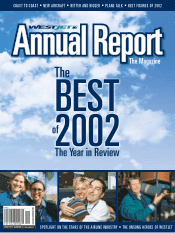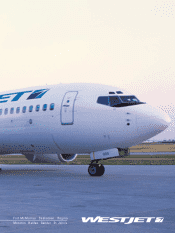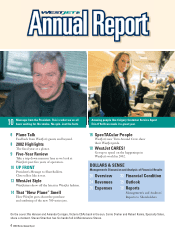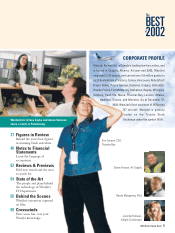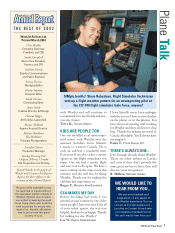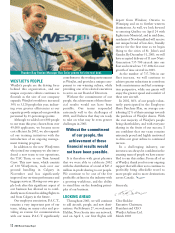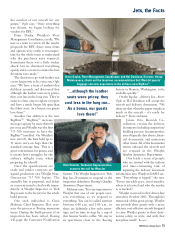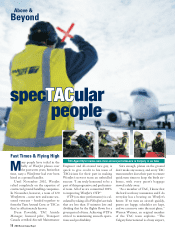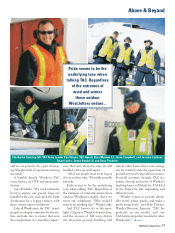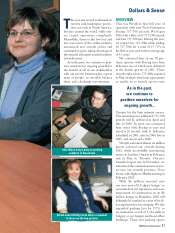Westjet 2002 Annual Report Download - page 11
Download and view the complete annual report
Please find page 11 of the 2002 Westjet annual report below. You can navigate through the pages in the report by either clicking on the pages listed below, or by using the keyword search tool below to find specific information within the annual report.
with the introduction of more 737-700
aircraft to our fleet has softened the
impact that this spike in price has had
on our results.
Our fuel hedging agreement expires
on June 30, 2003. For the first and sec-
ond quarters, our fuel needs will be
hedged at 28% and 25% respectively,
and we will continue to look for oppor-
tunities to further hedge our fuel as fuel
prices decline to a more favourable
long-term price level.
In the fourth quarter of 2002, we
took delivery of four purchased new
Boeing Next-Generation 737-700 air-
craft, which substantially increased our
capacity during this seasonally slow
period. The addition of these aircraft
allowed us to enhance our schedule and
route network, offering 1,310 depar-
tures per week as at December 31 on
our 21-city network. Due to the man-
ufacturer’s delivery schedule, these
aircraft were added in the
slowest quarter of the year,
and resulted in a slight
decline in our year-over-year
load factor from 74.7% in
2001 to 73.2% in 2002.
During the fourth quar-
ter, when we experienced a
54% growth rate, we main-
tained a load factor of 69%,
which was 1.5 percentage
points below last year’s load
factor during the same peri-
od. Given the magnitude of this growth,
coupled with the time of year this capac-
ity was added, these results are truly a
remarkable achievement.
With the addition of new aircraft in
our fleet, new cities to our network,
and new markets to our schedule, our
infrastructure growth has had to keep
pace with the growth of our operations.
Renovations to our Calgary hangar
began in 2002 and are slated for com-
pletion in early 2003. This addition of
55,000 square feet of space will not only
provide office space for our growing
team, but will also accommodate our
third flight simulator which is sched-
uled to be delivered in May 2003.
unfair tax. The recently announced
reduction to this charge of $5 per one-
way flight to take effect in March 2003
will help restore traffic on these routes;
however, we do not believe its effect
will be immediate. We will be moni-
toring these routes closely and will
adjust capacities as the demand dictates.
Another significant challenge facing
our industry in 2002 was the increasing
price of fuel, which was sparked by the
threat of war in Iraq and exacerbated by
problems in Venezuela. At year-end
2002, 32% of our fuel requirements
were fixed at a ceiling price of US
$18.60 per barrel; however, the
improved fuel efficiency that has come
2002 WestJet Annual Report 11
significance of the change in airline
strategy founded in 1971 with the first
flights of low-fare pioneer Southwest
Airlines.
The vast majority of air-travel pas-
sengers, particularly on short- to
mid-haul flights, are not prepared to
pay significantly more for a seat in order
to obtain points from a reward program
and possibly be served a meal, if a more
affordable option is available. These
additional services weigh heavily on the
price of airfares, and the travelling pub-
lic does not perceive that they provide
a proportionate increase in value.
Consequently, traditional carriers are
scrambling to survive, and are now
trying to emulate the efficiencies of
their lower-cost rivals.
WestJet has pioneered this evolution
in Canada, and we continue to adhere
to the principles that have secured our
success since our first flights. Our for-
mula is simple, but not easily replicated:
we provide an affordable, convenient,
enjoyable travel experience, with the
support of a low-cost structure.
By embracing advances in technol-
ogy, our unit costs continue to decrease
while our growth continues to dilute
our fixed costs. Our financial success
has allowed us to adopt Boeing’s next
generation of 737, the 700 series, and
its greater efficiency has allowed us to
reduce our operating costs signifi-
cantly. This year, we grew bookings
through the Internet to approximately
55% from 40% in 2001. Bookings
made through our website are not only
a means of reducing our costs, but our
guests have also clearly communicated
that they appreciate the convenience
that westjet.com offers.
In October, we entered into an
agreement with Worldwide Travel
Exchange (WWTE) (also known as
Expedia.ca) to offer car and hotel book-
ings on westjet.com. Through a link on
westjet.com, guests can book hotel
rooms and rent cars in every city we
serve, which further enhances conven-
ience for our guests, and the value of
our website.
There is now no doubt that
an evolution of our industry
is occurring both in Canada
and the United States...
CHALLENGES IN 2002
The Air Traveller’s Security Charge
(ATSC) – imposed in April 2002 – proved
to be a burden on our industry during
2002. Ultra-short-haul markets, like
Calgary-Edmonton and Vancouver-
Kelowna, were the most impacted by
this charge, and many guests opted to
drive or not travel at all as opposed to
paying this tax.
To mitigate the erosion caused by
the ATSC, we have successfully shifted
capacity off these ultra-short-haul
routes towards longer-haul routes while
we continued with our efforts to lobby
the government for changes to this
CSAs Darren Kooistra and Louise Winders
at Toronto’s Pearson Airport.
Up Front

